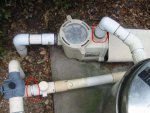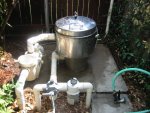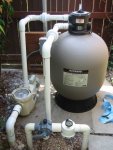Hello again.
The homeowner warranty people sent out the pool tech (Caribbean Blue Pools - Carrollton, TX) who charged me $65 to look at my broken filter and say "Yep, it's broken". I've got my fingers crossed that the warranty people will do the right thing and pop for a replacement (or at least a good portion of the $).
I'm currently using bleach, since the previous owner seemed unaware of the broken filter and "fixed" the problem by running the pump 24/7 and dumping in ridiculous amounts of stabilized tablets. My CYA level is well over 100. I'm considering installing an Autopilot SWCG once I get the filter issue taken care of, but have a question about the PVC plumbing.
I assume things would be re-plumbed by the pool tech if they replace the filter. However, if I take the $ from the warranty and DIY, it would be up to me. I've done PVC house plumbing before, so I'm comfortable cutting, using cement, etc.
In the attached pic, where the output comes from the pump, there appears to be a threaded fitting that goes into the pump & then the PVC is glued to it going into the filter. Would I just cut the PVC, then unscrew that fitting, replace with a new one and glue the new tubes to it?
The other area I'm concerned about is near the Jandy 3way valve. The elbow is glued to the valve, then a very short section of PVC before going into a ported "T" (I think they had an ionizer electrode in it a long time ago). It doesn't look like there's enough pipe to put a union on there if I cut the "T" off. Another option is to leave the T in place, and make my new filter connection to the right of the last joint, pushing the filter further to the right on the concrete pad, to leave the 12" of straight pipe necessary for the AutoPilot manifold. And I guess the last option is to also replumb the 3 way valve, energy filter, etc.
Can someone with PVC pool plumbing experience shed some light on the best way to handle this? Cheap is best, but I also like to do things right - I know, those aren't always compatible goals.
The homeowner warranty people sent out the pool tech (Caribbean Blue Pools - Carrollton, TX) who charged me $65 to look at my broken filter and say "Yep, it's broken". I've got my fingers crossed that the warranty people will do the right thing and pop for a replacement (or at least a good portion of the $).
I'm currently using bleach, since the previous owner seemed unaware of the broken filter and "fixed" the problem by running the pump 24/7 and dumping in ridiculous amounts of stabilized tablets. My CYA level is well over 100. I'm considering installing an Autopilot SWCG once I get the filter issue taken care of, but have a question about the PVC plumbing.
I assume things would be re-plumbed by the pool tech if they replace the filter. However, if I take the $ from the warranty and DIY, it would be up to me. I've done PVC house plumbing before, so I'm comfortable cutting, using cement, etc.
In the attached pic, where the output comes from the pump, there appears to be a threaded fitting that goes into the pump & then the PVC is glued to it going into the filter. Would I just cut the PVC, then unscrew that fitting, replace with a new one and glue the new tubes to it?
The other area I'm concerned about is near the Jandy 3way valve. The elbow is glued to the valve, then a very short section of PVC before going into a ported "T" (I think they had an ionizer electrode in it a long time ago). It doesn't look like there's enough pipe to put a union on there if I cut the "T" off. Another option is to leave the T in place, and make my new filter connection to the right of the last joint, pushing the filter further to the right on the concrete pad, to leave the 12" of straight pipe necessary for the AutoPilot manifold. And I guess the last option is to also replumb the 3 way valve, energy filter, etc.
Can someone with PVC pool plumbing experience shed some light on the best way to handle this? Cheap is best, but I also like to do things right - I know, those aren't always compatible goals.



 ), however using the outside/ inside option on jandy valves can make a fraction of an inch difference on the incoming pipe's entry, PVC has enough flex to accomodate it over a long enough run, but it still stresses the pipe - not having a 'dead straight' run could cause the proposed union to be a real PITA to get to seal properly. As there is a 50 - 50 chance of restricting flow anyway, I would opt for a 'pipe extender' - it's a coupling that glues into the ID of the pipe and 'bushes' up to the OD of the pipe. Had the valve been oriented so that the 90 wasn't needed, I think that using the 1.5" and bushing up would work, but the difference in the 'depth' of a 2" vs. 1.5" would strain the pipe too much -- I suppose a short run of flex pipe would alleviate this.
), however using the outside/ inside option on jandy valves can make a fraction of an inch difference on the incoming pipe's entry, PVC has enough flex to accomodate it over a long enough run, but it still stresses the pipe - not having a 'dead straight' run could cause the proposed union to be a real PITA to get to seal properly. As there is a 50 - 50 chance of restricting flow anyway, I would opt for a 'pipe extender' - it's a coupling that glues into the ID of the pipe and 'bushes' up to the OD of the pipe. Had the valve been oriented so that the 90 wasn't needed, I think that using the 1.5" and bushing up would work, but the difference in the 'depth' of a 2" vs. 1.5" would strain the pipe too much -- I suppose a short run of flex pipe would alleviate this. 
